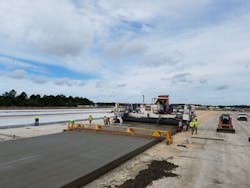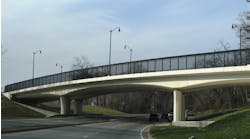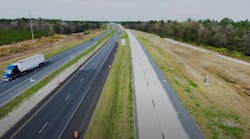Today’s modern concrete construction technologies and experienced personnel provide an opportunity to construct the smoothest concrete pavements and slabs in history.
Smooth pavements and slabs are in high demand because they reduce cracking, improve ride quality, reduce noise and improve fuel efficiency. One contributor to smoothness is caused by differential drying in the concrete that in turn causes upward slab curvature, or curl. This article focuses on comparing different methods of curing and their relative ability to reduce this phenomenon. Mitigation strategies also are discussed.
Drying out
Modern pavement and slab contracts often contain some language or criteria which attempts to control the smoothness that leads to curl. One challenge with these specifications is that there is little agreement on when the smoothness should be measured, the best way to measure it and whether the construction or design of the slab is most responsible for the smoothness. More clarity is needed to help the industry address these issues.
After concrete hardens, it still has many pores inside of it that are filled with fluid. As the concrete dries, these pores start to lose their moisture, and this causes the concrete to shrink. If water is added back to the concrete from rainfall then some of this shrinkage may be reversed, but some of it will remain. If this shrinkage happens on only one surface (for example, the top surface for a concrete pavement or slab) then this will cause the element to be strained more at one face than the other. This will cause bending (curling) that will increase the overall roughness.
As the concrete continues to dry, the curling will increase, and this will decrease the smoothness. This means that if a concrete pavement or slab is measured for smoothness at 30 days and then again at 90 days, it is possible to get very different measurements because different amounts of drying have occurred. One way to minimize this is to reduce moisture loss of the concrete pavement with proper curing.
Compounding matters
The most common methods used to cure concrete pavements employ a curing compound. These spray-on chemicals are economical and are widely used in the concrete construction industry to prevent loss of moisture from the surface of concrete. Unfortunately, it is not generally understood throughout the concrete industry that not all curing compounds have the same performance or cost. Because of this lack of understanding, contractors often choose the least expensive product. This may not be the best choice if smoothness is of importance.
Research completed at Oklahoma State University has investigated the impact of three different types of curing compounds and their ability to reduce moisture loss and curling. The three curing compounds investigated were: wax-based, resin-based and poly (alpha-Methylstyrene) or PAMS. The cost for the resin-curing compound was approximately twice the wax, and the PAMS was approximately three times.
One interesting result of the curling performance of the different curing compounds shows that if the wax-based curing compound was applied in two coats instead of one, even though the same amount of curing matter was used in both applications, there was a 20% decrease in curling. By using two layers, the imperfections from the first coat can be covered with the second without increasing the amount of material. The use of two layers of a surface coating is not something that is a new concept; however, the use of two coats is not a common practice in the use of curing compounds. The data shows that this simple modification in construction practices can make important improvements in smoothness.
Different coverage rates of curing compounds also were investigated in the testing. When using the manufacturer’s recommended coverage rate, the testing showed that the more expensive curing compounds showed improved performance. A vertical line has been included at the manufacturer’s recommended coverage rate for easy comparison. The results show that the PAMS-based curing compound performed the best and decreased curling in the laboratory specimens fivefold when compared to the least expensive, wax-based curing compound. The resin-based curing compound reduced curling by 2.5 times when compared to the wax-based curing compound. Even though these curing compounds are more expensive, this increased performance may help the contractor reduce the drying and therefore produce a smoother slab or pavement with less cracking. Even the reduction of a single issue on a construction project will likely be enough to justify any increased cost from the more expensive curing compounds.
It also is helpful to know how sensitive a curing compound is to the coverage rate. This gives insight into how sensitive the performance is to the application procedure. The least expensive curing compound (wax-based) was very sensitive to the coverage rate. If the coverage was decreased by 20% less than the manufactured recommended value, then the performance was similar to not using a curing compound at all. Both of the more expensive curing compounds were not as sensitive to the coverage rate and showed improved performance over the wax-based curing compound. This reduction in sensitivity to application rate is very beneficial and shows another benefit of the higher priced curing compound.
Testing also has been done on the impact of wet curing on the curling of concrete. While wet curing is not commonly used for slabs or pavements, it is sometimes required. Research showed that when concrete was wet- or sealed-cured and then placed in a high drying environment (< 50% RH), the wet- or sealed-cured concrete showed increased curling over not curing the concrete at all. In addition, as the wet-curing duration was increased, the measured curling also increased.
While this finding was surprising, it was validated with a wide range of testing in the lab and in the field, as well as with computer modeling. The research shows that the wet curing causes the pores in the concrete to decrease in size. Also, because of the external moisture applied to the surface of the concrete, the amount of solution in the sample is higher. This means that when the concrete dries, it will have a higher propensity to shrink. If wet curing is needed on a slab or pavement and the concrete will subsequently be exposed to severe drying (< 50% RH) then it is suggested to only cure the concrete for the minimum allowable time. After the wet curing is removed, it is recommended to place a curing compound on the surface. The curing compound will help reduce the drying rate of the concrete. While this may not reduce the ultimate curling of the concrete, it will reduce the rate at which curling occurs.
Not much potential
For slabs that are already in place, it is challenging to impact the influence of the moisture gradient on smoothness. If the smoothness is unsatisfactory, then diamond grinding can be used to restore a smooth surface. Before grinding it is good practice to monitor the curling of the structure over time to ensure that the curling is stable. If grinding is done too early, then the slab will continue to curl as it dries. This may require future diamond grinding to restore smoothness.
Designing concrete pavements with a lower potential for curling is the most cost effective mitigation strategy. Some techniques to do this include:
- Design the pavement to have a reduced cement and water content by using a favorable aggregate gradation that minimizes edge slumping and maximizes consistency and finishing; and
- Use of shorter slabs with dowelled joints or the use of continuous reinforcing steel throughout the slab to minimize transverse joints.
The development of upward slab curvature has the potential to decrease slab smoothness, even when no distress is present. The use of high-quality curing compounds, careful selection of mixture proportions and intelligent design can reduce the occurrence of curling in new construction. Grinding of rough concrete pavements can result in an immediate reduction in roughness due to slab curvature.



